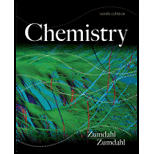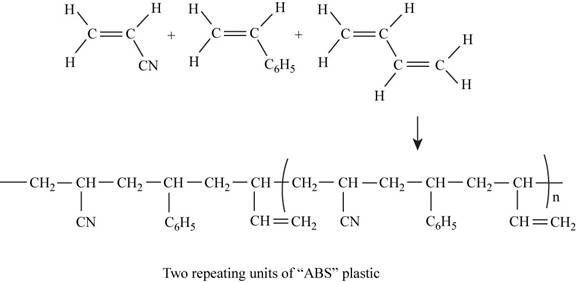
(a)
Interpretation: The two repeating units of ABS plastic assuming the three monomer units react in a
Concept introduction: The
To determine: The structure of two repeating units of ABS plastic assuming the three monomer units react in a
(a)
Answer to Problem 154CP
Answer
The two repeating units of ABS plastic are shown in Figure 1.
Explanation of Solution
Explanation
The structure of the polymer of ABS plastic is shown in figure 1.
The reaction of Abs

Figure 1
ABS plastic is a terpolymer synthesized by polymerizing styrene, acrylonitrile and polybutadiene. The chemical formula of ABS polymer is
(b)
Interpretation: The two repeating units of ABS plastic assuming the three monomer units react in a
Concept introduction: The polymers (repeating structural units) are derived from the simple and reactive molecules, called as monomers. ABS plastic is a terpolymer of styrene, acrylonitrile and polybutadiene.
To determine: The percent by mass of acrylonitrile, butadiene and styrene in the polymer sample.
(b)
Answer to Problem 154CP
Answer
The mass percent of acrylonitrile is
The mass percent of butadiene is
The mass percent of styrene is
Explanation of Solution
Explanation
The mass percent of the three given monomers is calculated below.
Given
The mass of bromine to react completely with ABS plastic is
The mass of ABS plastic is
The molar mass of bromine is
The number of moles is calculated by the formula,
Substitute the given value of the mass and molar mass of bromine in the above expression.
Hence, each molecule in this polymer contains
Therefore,
The ABS plastic is constructed by equimolar ratio of the three molecules. Hence, each molecule is
Therefore,
The mass of acrylonitrile, styrene and butadiene is calculated as,
The molar mass of acrylonitrile is
The molar mass of butadiene is
The molar mass of styrene is
The mass of acrylonitrile, styrene and butadiene is calculated by using the formula,
Substitute the given value of the number of moles and molar mass of in the above expression.
For acrylonitrile,
For butadiene,
For styrene
Therefore,
Mass percent of acrylonitrile, styrene and butadiene is calculated as,
For acrylonitrile,
For butadiene,
For styrene
(c)
Interpretation: The two repeating units of ABS plastic assuming the three monomer units react in a
Concept introduction: The polymers (repeating structural units) are derived from the simple and reactive molecules, called as monomers. ABS plastic is a terpolymer of styrene, acrylonitrile and polybutadiene.
To determine: The relative numbers of monomer units in the given sample of ABS plastic.
(c)
Answer to Problem 154CP
Answer
The three monomer units are in
Explanation of Solution
Explanation
The relative numbers of the monomer unit in ABS sample is explained below.
On the basis of the above results it is considered that the three monomer unit’s; acrylonitrile, butadiene and styrene are present in
Want to see more full solutions like this?
Chapter 22 Solutions
Chemistry
- Draw the skeletal ("line") structure of 2-hydroxy-4-methylpentanal. Click and drag to start drawing a structure. Xarrow_forwardDetermine whether the following molecule is a hemiacetal, acetal, or neither and select the appropriate box below. Also, highlight the hemiacetal or acetal carbon if there is one. hemiacetal acetal Oneither OHarrow_forwardWhat is the missing reactant R in this organic reaction? ་ ་ ་ ་ ་ ་ ་ ་ ་ ་ +R H3O+ • Draw the structure of R in the drawing area below. N • Be sure to use wedge and dash bonds if it's necessary to draw one particular enantiomer. Click and drag to start drawing a structure.arrow_forward
- Write the systematic name of each organic molecule: H structure H OH OH H OH name ☐ OHarrow_forwardDetermine whether each of the following molecules is a hemiacetal, acetal, or neither and select the appropriate box in the table. CH3O OH OH OH hemiacetal acetal neither hemiacetal acetal neither Xarrow_forwardWhat is the missing reactant R in this organic reaction? N N དལ་ད་་ + R • Draw the structure of R in the drawing area below. • Be sure to use wedge and dash bonds if it's necessary to draw one particular enantiomer. Click and drag to start drawing a structure. ㄖˋarrow_forward
- Draw the condensed structure of 4-hydroxy-3-methylbutanal. Click anywhere to draw the first atom of your structure.arrow_forwardUsing the bond energy values, calculate the energy that must be supplied or is released upon the polymerization of 755 monomers. If energy must be supplied, provide a positive number; if energy is released, provide a negative number. Hint: Avogadro’s number is 6.02 × 1023.arrow_forward-AG|F=2E|V 3. Before proceeding with this problem you may want to glance at p. 466 of your textbook where various oxo-phosphorus derivatives and their oxidation states are summarized. Shown below are Latimer diagrams for phosphorus at pH values at 0 and 14: Acidic solution -0.93 +0.38 -0.51 -0.06 H3PO4 →H4P206 H3PO3 H3PO2 → P→ PH3 -0.28 -0.50 → -0.50 Basic solution 3-1.12 -1.57 -2.05 -0.89 PO HPO →→H2PO2 P PH3 -1.73 a) Under acidic conditions, H3PO4 can be reduced into H3PO3 directly (-0.28V), or via the formation and reduction of H4P2O6 (-0.93/+0.38V). Calculate the values of AG's for both processes; comment. (3 points) 0.5 PH, 0.0 -0.5- 2 3 9 3 -1.5 -2.0 Pa H,PO H,PO H,PO -3 -1 0 2 4 Oxidation state, N 2 b) Frost diagram for phosphorus under acidic conditions is shown. Identify possible disproportionation and comproportionation processes; write out chemical equations describing them. (2 points) c) Elemental phosphorus tends to disproportionate under basic conditions. Use data in…arrow_forward
- These two reactions appear to start with the same starting materials but result in different products. How do the chemicals know which product to form? Are both products formed, or is there some information missing that will direct them a particular way?arrow_forwardWhat would be the best choices for the missing reagents 1 and 3 in this synthesis? 1. PPh3 3 1 2 2. n-BuLi • Draw the missing reagents in the drawing area below. You can draw them in any arrangement you like. • Do not draw the missing reagent 2. If you draw 1 correctly, we'll know what it is. • Note: if one of your reagents needs to contain a halogen, use bromine. Explanation Check Click and drag to start drawing a structure. 2025 McGraw Hill LLC. All Rights Reserved. Terms of Use | Priva ×arrow_forwardPredict the products of this organic reaction: Explanation Check IN NaBH3CN H+ ? Click and drag to start drawing a structure. D 5 C +arrow_forward
 Chemistry: Principles and ReactionsChemistryISBN:9781305079373Author:William L. Masterton, Cecile N. HurleyPublisher:Cengage Learning
Chemistry: Principles and ReactionsChemistryISBN:9781305079373Author:William L. Masterton, Cecile N. HurleyPublisher:Cengage Learning World of Chemistry, 3rd editionChemistryISBN:9781133109655Author:Steven S. Zumdahl, Susan L. Zumdahl, Donald J. DeCostePublisher:Brooks / Cole / Cengage Learning
World of Chemistry, 3rd editionChemistryISBN:9781133109655Author:Steven S. Zumdahl, Susan L. Zumdahl, Donald J. DeCostePublisher:Brooks / Cole / Cengage Learning Introductory Chemistry: An Active Learning Approa...ChemistryISBN:9781305079250Author:Mark S. Cracolice, Ed PetersPublisher:Cengage Learning
Introductory Chemistry: An Active Learning Approa...ChemistryISBN:9781305079250Author:Mark S. Cracolice, Ed PetersPublisher:Cengage Learning Introductory Chemistry: A FoundationChemistryISBN:9781337399425Author:Steven S. Zumdahl, Donald J. DeCostePublisher:Cengage Learning
Introductory Chemistry: A FoundationChemistryISBN:9781337399425Author:Steven S. Zumdahl, Donald J. DeCostePublisher:Cengage Learning Principles of Modern ChemistryChemistryISBN:9781305079113Author:David W. Oxtoby, H. Pat Gillis, Laurie J. ButlerPublisher:Cengage Learning
Principles of Modern ChemistryChemistryISBN:9781305079113Author:David W. Oxtoby, H. Pat Gillis, Laurie J. ButlerPublisher:Cengage Learning Chemistry: The Molecular ScienceChemistryISBN:9781285199047Author:John W. Moore, Conrad L. StanitskiPublisher:Cengage Learning
Chemistry: The Molecular ScienceChemistryISBN:9781285199047Author:John W. Moore, Conrad L. StanitskiPublisher:Cengage Learning





